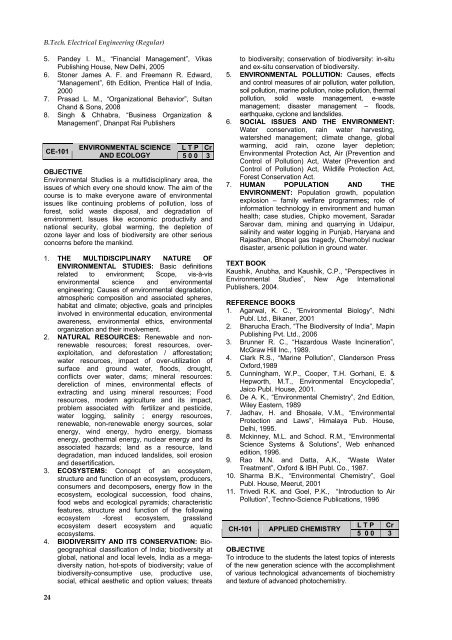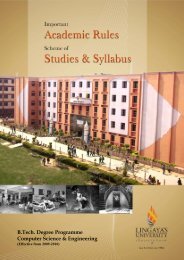B.<strong>Tech</strong>. <strong>Electrical</strong> <strong>Engineering</strong> (Regular)5. Pandey I. M., “Financial Management”, VikasPublishing House, New Delhi, 20056. Stoner James A. F. and Freemann R. Edward,“Management”, 6th Edition, Prentice Hall of India,20007. Prasad L. M., “Organizational Behavior”, SultanChand & Sons, 20088. Singh & Chhabra, “Business Organization &Management”, Dhanpat Rai PublishersCE-101ENVIRONMENTAL SCIENCE L T P CrAND ECOLOGY 5 0 0 3OBJECTIVEEnvironmental Studies is a multidisciplinary area, theissues of which every one should know. The aim of thecourse is to make everyone aware of environmentalissues like continuing problems of pollution, loss offorest, solid waste disposal, and degradation ofenvironment. Issues like economic productivity andnational security, global warming, the depletion ofozone layer and loss of biodiversity are other seriousconcerns before the mankind.1. THE MULTIDISCIPLINARY NATURE OFENVIRONMENTAL STUDIES: Basic definitionsrelated to environment; Scope, vis-à-visenvironmental science and environmentalengineering; Causes of environmental degradation,atmospheric composition and associated spheres,habitat and climate; objective, goals and principlesinvolved in environmental education, environmentalawareness, environmental ethics, environmentalorganization and their involvement.2. NATURAL RESOURCES: Renewable and nonrenewableresources; forest resources, overexploitation,and deforestation / afforestation;water resources, impact of over-utilization ofsurface and ground water, floods, drought,conflicts over water, dams; mineral resources:dereliction of mines, environmental effects ofextracting and using mineral resources; Foodresources, modern agriculture and its impact,problem associated with fertilizer and pesticide,water logging, salinity ; energy resources,renewable, non-renewable energy sources, solarenergy, wind energy, hydro energy, biomassenergy, geothermal energy, nuclear energy and itsassociated hazards; land as a resource, landdegradation, man induced landslides, soil erosionand desertification.3. ECOSYSTEMS: Concept of an ecosystem,structure and function of an ecosystem, producers,consumers and decomposers, energy flow in theecosystem, ecological succession, food chains,food webs and ecological pyramids; characteristicfeatures, structure and function of the followingecosystem -forest ecosystem, grasslandecosystem desert ecosystem and aquaticecosystems.4. BIODIVERSITY AND ITS CONSERVATION: Biogeographicalclassification of India; biodiversity atglobal, national and local levels, India as a megadiversitynation, hot-spots of biodiversity; value ofbiodiversity-consumptive use, productive use,social, ethical aesthetic and option values; threatsto biodiversity; conservation of biodiversity: in-situand ex-situ conservation of biodiversity.5. ENVIRONMENTAL POLLUTION: Causes, effectsand control measures of air pollution, water pollution,soil pollution, marine pollution, noise pollution, thermalpollution, solid waste management, e-wastemanagement; disaster management – floods,earthquake, cyclone and landslides.6. SOCIAL ISSUES AND THE ENVIRONMENT:Water conservation, rain water harvesting,watershed management; climate change, globalwarming, acid rain, ozone layer depletion;Environmental Protection Act, Air (Prevention andControl of Pollution) Act, Water (Prevention andControl of Pollution) Act, Wildlife Protection Act,Forest Conservation Act.7. HUMAN POPULATION AND THEENVIRONMENT: Population growth, populationexplosion – family welfare programmes; role ofinformation technology in environment and humanhealth; case studies, Chipko movement, SaradarSarovar dam, mining and quarrying in Udaipur,salinity and water logging in Punjab, Haryana andRajasthan, Bhopal gas tragedy, Chernobyl nucleardisaster, arsenic pollution in ground water.TEXT BOOKKaushik, Anubha, and Kaushik, C.P., “Perspectives inEnvironmental Studies”, New Age InternationalPublishers, 2004.REFERENCE BOOKS1. Agarwal, K. C., “Environmental Biology”, NidhiPubl. Ltd., Bikaner, 20012. Bharucha Erach, “The Biodiversity of India”, MapinPublishing Pvt. Ltd., 20063. Brunner R. C., “Hazardous Waste Incineration”,McGraw Hill Inc., 1989.4. Clark R.S., “Marine Pollution”, Clanderson PressOxford,19895. Cunningham, W.P., Cooper, T.H. Gorhani, E. &Hepworth, M.T., Environmental Encyclopedia”,Jaico Publ. House, 2001.6. De A. K., “Environmental Chemistry”, 2nd Edition,Wiley Eastern, 19897. Jadhav, H. and Bhosale, V.M., “EnvironmentalProtection and Laws”, Himalaya Pub. House,Delhi, 1995.8. Mckinney, M.L. and Schocl. R.M., “EnvironmentalScience Systems & Solutions”, Web enhancededition, 1996.9. Rao M.N. and Datta, A.K., “Waste WaterTreatment”, Oxford & IBH Publ. Co., 1987.10. Sharma B.K., “Environmental Chemistry”, GoelPubl. House, Meerut, 200111. Trivedi R.K. and Goel, P.K., “Introduction to AirPollution”, <strong>Tech</strong>no-Science Publications, 1996CH-101APPLIED CHEMISTRYL T P Cr5 0 0 3OBJECTIVETo introduce to the students the latest topics of interestsof the new generation science with the accomplishmentof various technological advancements of biochemistryand texture of advanced photochemistry.24
Lingaya’s University, Faridabad1. PHASE RULE: Terminology of phases;components and degree of freedom; derivation ofGibbs phase rule equation; one component system(water system); application of reduced / condensedphase rule; two component system; eutectic (Pb-Ag) system; congruent (Zn-Mg) system;Incongruent system (Na-K) system; merits anddemerits of phase rule.2. THERMODYNAMICS: Entropy; entropy change foran ideal gas; free energy and its physicalsignificance; variation of free energy withtemperature and pressure; work function and itssignificance; relation between Gibb’s free energyand work function; second law of thermodynamics;Gibbs Helmholtz equation; Its application andsignificance; chemical potential; Gibbs Duhemequation; Clausius Clapeyron equation and itsapplication.3. WATER AND ITS TREATMENT: Specification ofwater for different uses; hardness of water;equivalent of calcium carbonate; units of hardness;disadvantages of hard water and determination ofhardness; alkalinity of water and its determination;related numericals; scale and sludge formation inboilers and its prevention; caustic embrittlement;water softening; Zeolite process; Ion exchangeprocess and mixed bed demineralization;disinfection of water; desalination; reverseosmosis; electrodialysis.4. CORROSION AND ITS PREVENTION:Introduction; classification; dry and wetcorrosion; electrochemistry theory of corrosion;galvanic, pitting and waterline corrosion;differential aeration corrosion; stress corrosion;factors affecting corrosion; preventive measures;material selection; proper designing; barrierprotection; sacrificial protection; cathodic; anodicprotection.5. LUBRICATION AND LUBRICANTS: Friction;mechanism of lubrication; classification oflubricants; additives of lubricants; syntheticlubricants; properties of lubricants; consistency;drop point; fire and flash point; cloud point; pourpoint; viscosity; viscosity index; Iodine no.; anilineno.; saponification no.; steam emulsion no.;neutralization no.; decomposition stability and theirsignificance.6. PHOTOCHEMISTRY: Photochemical and darkreactions; laws of photochemistry; quantumefficiency; classification of photochemical reactionson the basis of their quantum efficiencies; nonradiativeprocesses (ISC and IC); fluorescence;phosphorescence (Jablonski diagram);chemiluminiscence; photosensitization; technologybased on photochemical processes.7. BIOMOLECULES: Structure; function; diversityand distribution; general composition of livingmatter. carbohydrates; monosaccharides andtheir inter-relationship; structure of sugars;glucose; fructose; maltose; lactose, sucrose;stereoisomerism and optical isomerism ofsugars; ring structure and tautomeric form andmutarotation; lipids: definitions; classification oflipids; fatty acids; glycerol; building block of lipid;proteins and amino acid; classification andformulae; proteinous and non-proteinous;essential and non-essential amino-acids;primary, secondary, tertiary, quaternarystructure of proteins; N and C terminaldetermination.TEXT BOOKSrivastava, H.C., “<strong>Engineering</strong> Chemistry”, PragatiPrakashan Publishing House.REFERENCE BOOKS1. Chawla, Shashi, “<strong>Engineering</strong> Chemistry”, FirstEdition, Dhanpat Rai and Co., 20032. Ambasta, B.K, “<strong>Engineering</strong> Chemistry”, LaxmiPublications, 20073. Singh, Devender and Vats Satish K.,“Comprehensive <strong>Engineering</strong> Chemistry”, I. K.International Publication, 20074. Chatwal Gurdeep “Organic Chemistry on NaturalProducts”, Vol. 1, Himalaya Publishing House,Reprint 2002.5. Chatwal Gurdeep, “Photochemistry”, HimalayaPublishing House, 2003.6. Jain, P.C., and Jain, Monica, “<strong>Engineering</strong>Chemistry”, Dhanpat Rai & Co.7. Morrison, R.T., and Boyd, R.N., “OrganicChemistry”, 6th Edition, PearsonEducation,1994CH-151APPLIED CHEMISTRY LABL T P Cr0 0 2 1LIST OF EXPERIMENTS1. Determination of Ca++ and Mg++ hardness ofwater using EDTA solution.2. Determination of alkalinity of water sample.3. Find the melting and eutectic point for a twocomponent system by using method of coolingcurve.4. Determination of viscosity of lubricant by RedWood viscometer (No. 1 & No. 2).5. Prepare Phenol-formaldehyde and Ureaformaldehyde resin.6. Find out Saponification number of oil.7. Determination of concentration of KMnO 4 solutionspectro-photometerically.8. Determination of strength of HCl solution bytitrating it against NaOH solutionconductometerically.9. Determination of drop point of given lubricant usingdrop point apparatus.10. Estimate the sugar (Glucose) using Fehlingsolution method.11. Determine flash point and fire point of oil byPensky - Marten's flash point apparatus.12. Determine amount of sodium and potassium in agiven water sample by flame photometer.REFERENCE BOOKS1. Dara, S. S. “A Text Book on Experimental andCalculation – <strong>Engineering</strong> Chemistry”, S. Chand &Company.2. Chawla, Shashi, “Essential of Experimental<strong>Engineering</strong> Chemistry”, 2nd Edition, Dhanpat RaiPublishing Company, 20063. Virmani, O. P., and Narula, A. K., “Theory &Practice Applied Chemistry”, New AgePublications.25
- Page 1 and 2: B.Tech. Degree ProgrammeElectrical
- Page 5 and 6: Lingaya’s University, FaridabadAB
- Page 7 and 8: IMPORTANT ACADEMIC RULESB.Tech. Deg
- Page 9 and 10: Lingaya’s University, Faridabadac
- Page 11 and 12: Lingaya’s University, FaridabadSe
- Page 13 and 14: Lingaya’s University, FaridabadIn
- Page 15 and 16: CATEGORY-WISE LIST OF COURSESLingay
- Page 17 and 18: Lingaya’s University, FaridabadSU
- Page 19 and 20: Lingaya’s University, FaridabadSc
- Page 22 and 23: B.Tech. Electrical Engineering (Reg
- Page 24 and 25: B.Tech. Electrical Engineering (Reg
- Page 26 and 27: B.Tech. Electrical Engineering (Reg
- Page 30 and 31: B.Tech. Electrical Engineering (Reg
- Page 32 and 33: B.Tech. Electrical Engineering (Reg
- Page 34 and 35: B.Tech. Electrical Engineering (Reg
- Page 36 and 37: B.Tech. Electrical Engineering (Reg
- Page 38 and 39: B.Tech. Electrical Engineering (Reg
- Page 40 and 41: B.Tech. Electrical Engineering (Reg
- Page 42 and 43: B.Tech. Electrical Engineering (Reg
- Page 44 and 45: B.Tech. Electrical Engineering (Reg
- Page 46 and 47: B.Tech. Electrical Engineering (Reg
- Page 48 and 49: B.Tech. Electrical Engineering (Reg
- Page 50 and 51: B.Tech. Electrical Engineering (Reg
- Page 52 and 53: B.Tech. Electrical Engineering (Reg
- Page 54 and 55: B.Tech. Electrical Engineering (Reg
- Page 56 and 57: B.Tech. Electrical Engineering (Reg
- Page 58 and 59: B.Tech. Electrical Engineering (Reg
- Page 60 and 61: B.Tech. Electrical Engineering (Reg
- Page 62 and 63: B.Tech. Electrical Engineering (Reg
- Page 64 and 65: B.Tech. Electrical Engineering (Reg
- Page 66 and 67: B.Tech. Electrical Engineering (Reg
- Page 68 and 69: B.Tech. Electrical Engineering (Reg
- Page 71 and 72: OPEN ELECTIVELingaya’s University
- Page 73 and 74: Lingaya’s University, Faridabadch
- Page 75 and 76: Lingaya’s University, Faridabad4
- Page 77 and 78: Lingaya’s University, Faridabad6.
- Page 79 and 80:
Lingaya’s University, FaridabadEL
- Page 81 and 82:
Lingaya’s University, Faridabad5
- Page 83 and 84:
Lingaya’s University, Faridabador
- Page 85 and 86:
Lingaya’s University, Faridabad4.
- Page 87:
Lingaya’s University, Faridabad83
















